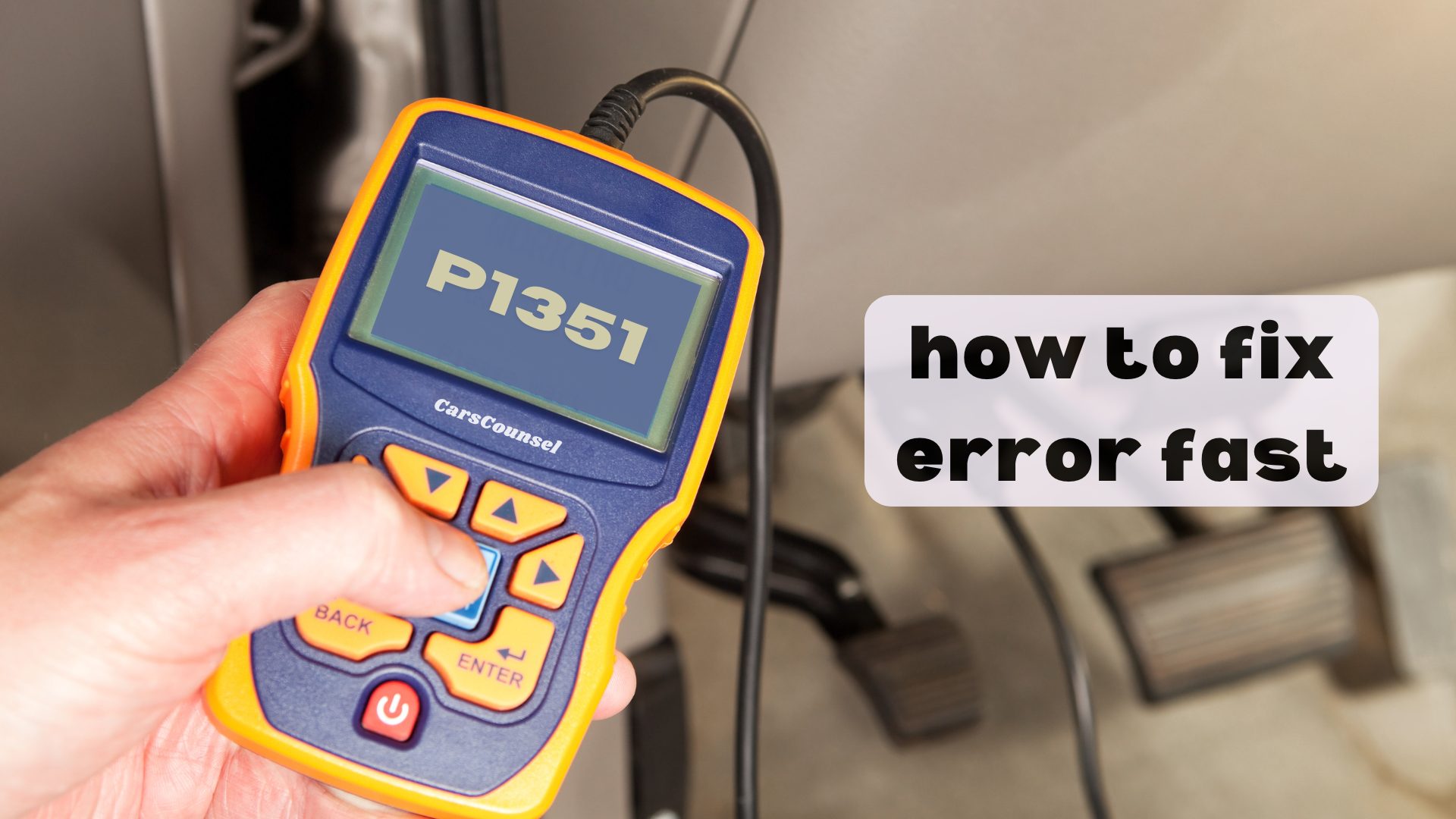Dealing with a P1351 code can be frustrating, but you can fix it quickly with the right steps.
Start by checking the ignition control circuit and Variable Valve Timing (VVT) components for any visible issues.
Use a multimeter to test the ignition coil module, crankshaft position sensor, and VVT solenoids to find the problem.
Replace any faulty parts like worn spark plugs or damaged wiring.
After making the repairs, clear the code with a diagnostic scanner.
But what if the OBD2 code comes back?

Quick Navigation
Key Takeaways
- Look at the ignition coil modules and replace any that are faulty to stop misfires.
- Check the crankshaft position sensor and swap it out if needed.
- Check the spark plugs and wires, and replace them if they are worn out.
- Test the VVT solenoids and sensors to make sure they work properly.
What Is the P1351 Code?
The P1351 code indicates a problem with the ignition control circuit and is often related to issues in the variable valve timing (VVT) system.
When the powertrain control module (PCM) detects a disruption in these systems, it affects the ignition timing, which is crucial for optimal engine performance. The PCM constantly monitors the ignition and VVT systems, and if it detects any inconsistencies, it will trigger the check engine light.
Problems with the ignition system can lead to misfires or even engine damage if not addressed. Issues with the VVT system can cause poor engine performance and lower fuel efficiency.
It’s important to fix the P1351 code promptly to maintain your vehicle’s performance and avoid further complications. Ignoring this code can lead to expensive repairs and reduce your engine’s lifespan.
Common Causes of P1351
Understanding the common causes of the P1351 code can help you fix the problem quickly and effectively.
This error is usually due to issues in the ignition system or faulty VVT sensors. Some common reasons include a bad ignition coil module, which can cause misfires, or a faulty crankshaft position sensor that messes up the ignition timing.
Worn-out spark plugs or wires can lead to weak or erratic sparks, and failing ignition coils mightn’t produce enough voltage.
Problems with the VVT system, like defective sensors or solenoids, can also trigger the P1351 code.
Additionally, damaged wiring can affect how well both the ignition system and VVT components work.
Ignition Coil Module Issues
Problems with the ignition coil module can cause engine misfires, issues starting the car, or erratic performance. This makes it a key area to check when dealing with a P1351 code.
To begin, use a multimeter to test the ignition coil module for continuity and proper voltage. Failures in the ignition module can be due to internal shorts or open circuits, which mess up the spark generation process.
Here are some steps to troubleshoot: look for any physical damage, corrosion, or loose connections. Make sure all the wiring is intact and properly connected.
If the ignition coil module doesn’t pass these tests, you’ll need to replace it to get the engine running smoothly again and clear the P1351 code.
Always follow the manufacturer’s guidelines for accurate diagnostics and repairs.
Crankshaft Position Sensor Problems
If your crankshaft position sensor isn’t working right, it can mess up your ignition timing and cause the P1351 code to pop up. This sensor is crucial because it keeps track of where your crankshaft is and how fast it’s spinning. When it goes bad, your car’s computer gets the wrong info and that can lead to ignition problems.
Here’s what you can do:
- Check the Crankshaft Sensor: See if it’s worn out or damaged.
- Test the Sensor: Use a multimeter to make sure the voltage and resistance are what they should be.
- Look at the Wiring and Connections: Make sure nothing is loose or corroded that’s connected to the sensor.
- Replace if Needed: If the sensor isn’t working right, get a new one and swap it out.
Spark Plugs and Wires
Once you’ve checked the crankshaft position sensor, focus on the spark plugs and wires. These are crucial for creating strong, consistent sparks needed for ignition.
Look at each spark plug for wear or damage and replace any that don’t look good to ensure they work at their best. Check the wires for any cracks or signs of rust, as good wires are essential for reliable signals.
Bad plugs or wires can cause weak or irregular sparks, making ignition problems worse. Use a multimeter to test the wires’ resistance and make sure they match the manufacturer’s specifications.
Regularly maintaining your spark plugs and keeping the wires in good shape can greatly improve ignition performance and help fix the P1351 code.
Variable Valve Timing Issues
When dealing with the P1351 code, you need to check the variable valve timing (VVT) system for any problems with sensors or solenoids that might be causing the issue. Poor VVT performance can lead to engine inefficiency and error codes.
To make sure your VVT system is in good shape, follow these steps:
- Look at VVT Sensors: Check if they’re damaged or worn out.
- Test VVT Solenoids: Use a multimeter to see if they’re working correctly.
- Check Oil Levels: Make sure the oil isn’t low or dirty, as this can affect VVT performance.
- Inspect Wiring: Look for any wires that are frayed or corroded.
Keeping these parts in good condition ensures your engine runs well and helps prevent the P1351 code from coming back.
Regular VVT maintenance is important to avoid expensive repairs and long-term engine problems.
Car Models Affected by P1351
Chevrolet Camaro, Cadillac Seville, and GMC Sierra often run into the P1351 trouble code because of their specific ignition systems and variable valve timing (VVT).
This code usually points to problems with the ignition control circuit, which can mess up engine performance. The Camaro’s ignition control module, the Seville’s Northstar V8 engine, and the Sierra’s V8 engines are especially prone to this issue.
Other cars with similar ignition systems and VVT setups can also get this code. How often this code shows up can change depending on the model year and setup, especially in older cars.
Knowing which vehicles are commonly affected can help you find and fix problems more effectively to keep your engine running smoothly.
Steps to Diagnose P1351
To diagnose the P1351 code, start by looking over the ignition system parts and the VVT (Variable Valve Timing) parts for any visible damage or wear. Use the right diagnostic tools to make sure you get an accurate assessment.
Follow these steps:
- Test the Ignition Coil Module: Use a multimeter to check for continuity and voltage.
- Check the Wiring and Connections: Look for damage, corrosion, or loose connections that might affect the ignition and VVT systems.
- Use a Diagnostic Scanner: Confirm the P1351 code and gather more information about how the engine is performing.
- Test the Components: Check the VVT solenoid and sensor to make sure they’re working properly.
Fixing the P1351 Code
To fix the P1351 code, start by replacing any faulty parts like the ignition coil module, crankshaft position sensor, and VVT solenoid. Making sure these components are working correctly is crucial for keeping your engine running smoothly.
Check the spark plugs and wires, and replace them if they look worn out to ensure a strong and consistent spark. Look over the wiring and connections around the ignition system and VVT parts for any damage or rust.
Use a diagnostic scanner to make sure the code is gone. After replacing the faulty parts, keep an eye on how the engine runs. Watch for any misfires or poor acceleration to make sure everything is fixed.
Preventing Future P1351 Errors
To avoid future P1351 errors, make sure to regularly check and take care of your car’s ignition system and VVT parts. Here’s how you can keep your car in good shape:
- Regular Checks: Look at your ignition coils, spark plugs, and wires often to see if they’re worn out.
- Watch VVT Parts: Make sure the VVT sensors and solenoids are working right.
- Inspect Wiring: Check electrical connections for any rust or damage that might mess up signals.
- Stick to Maintenance Schedule: Follow the maintenance schedule from the manufacturer, including changing the engine oil on time.
More OBD-II Codes
Frequently Asked Questions
Can Driving With the P1351 Code Cause Long-Term Engine Damage?
Yes, driving with the P1351 code can harm your engine over time. If you ignore it, you might experience performance problems, engine misfires, and possible damage. Fix the faulty ignition parts and the VVT system quickly to avoid expensive repairs.
How Much Does It Typically Cost to Fix the P1351 Code?
Fixing the P1351 code usually costs between $150 and $500. The exact price depends on labor costs and parts. Getting it fixed by a professional can save you from more expensive engine problems down the road.
Are There Any Temporary Fixes for the P1351 Code?
For quick fixes, you can reset the car’s computer to clear the code. Also, check and clean the ignition coil connections. But keep in mind, these are only temporary solutions. You’ll still need to do a detailed check to find and fix the main problem.
Can the P1351 Code Affect My Car’s Fuel Efficiency?
Imagine your car using more fuel than normal. Yes, the P1351 code can make your car’s fuel efficiency worse by messing with the engine’s performance. This leads to bad combustion and more fuel being used. Fix it quickly.
What Tools Do I Need to Diagnose the P1351 Code at Home?
To figure out the P1351 code at home, you’ll need a code reader to check what the code is and a multimeter to test the ignition coil module and wiring. These tools will help you find out what’s wrong and which parts need fixing.
Conclusion
By fixing the P1351 code quickly, you can avoid more engine damage and keep your car running well.
A bad ignition coil can cut your fuel efficiency by up to 30%.
Check and replace any damaged parts like the ignition coil module, crankshaft position sensor, and spark plugs to ensure your car runs smoothly.
After making the repairs, use a diagnostic scanner to clear the code and keep an eye on the engine for any new problems.

